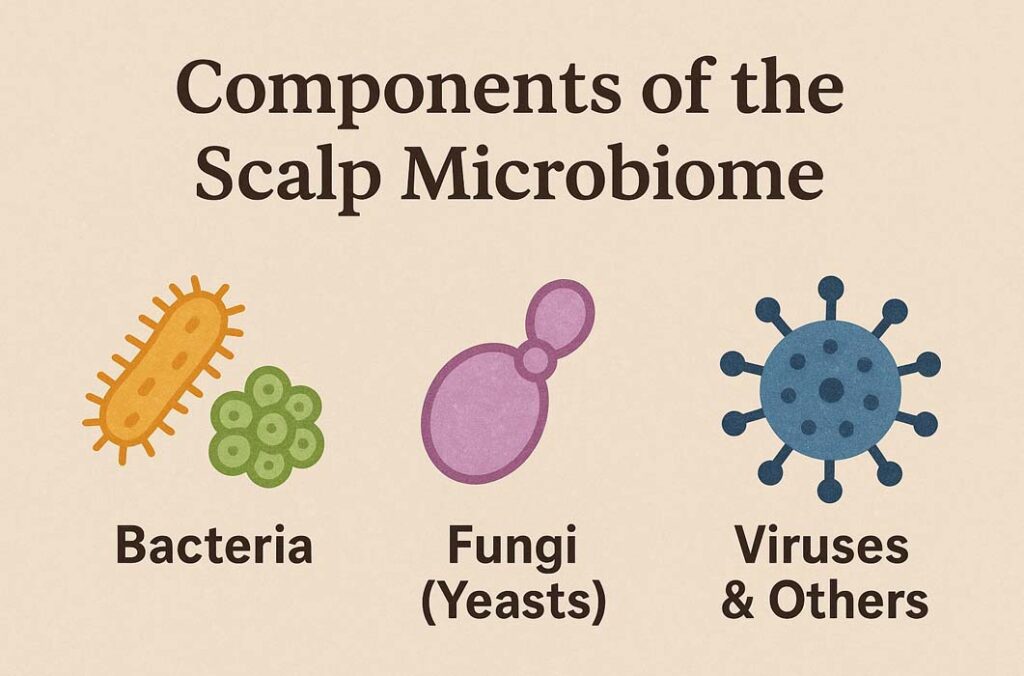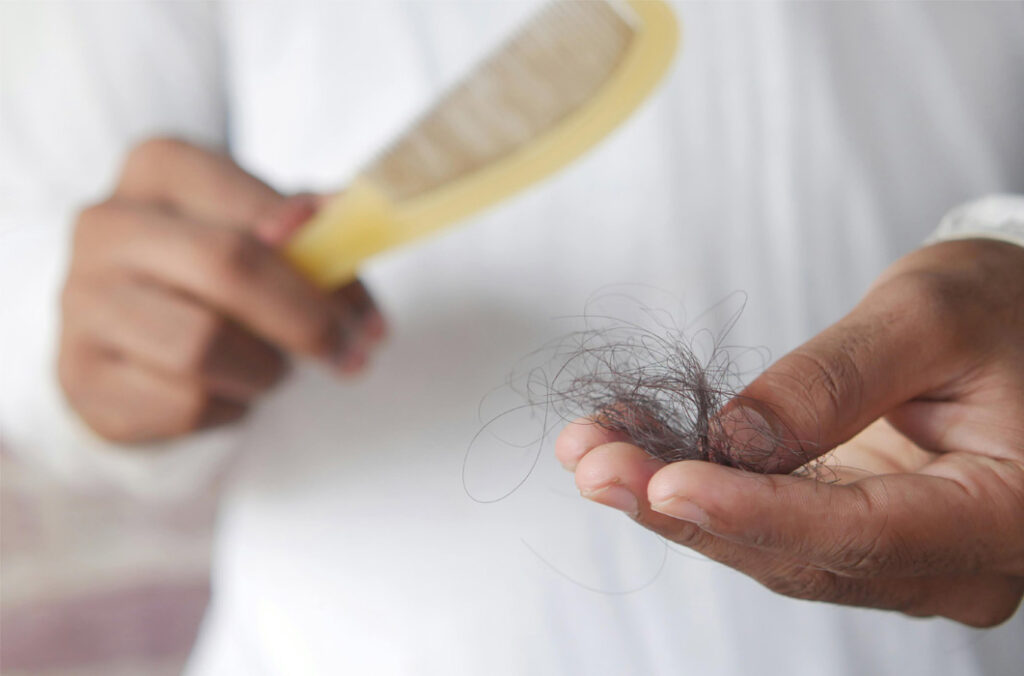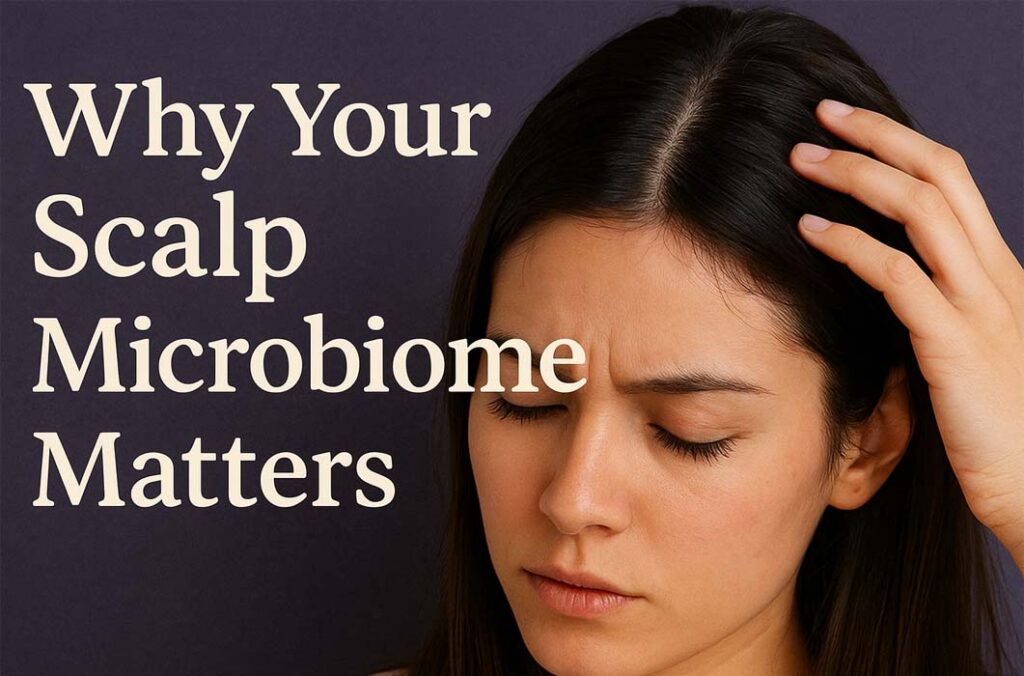If you have ever struggled with stubborn dandruff, an itchy scalp, or unexplained hair loss, chances are you’ve blamed your shampoo or hair oil. But what if the real reason was something far smaller, something invisible — a hidden world of scalp microbiomequietly living on your scalp?
This invisible ecosystem is called the scalp microbiome. It’s made up of bacteria, fungi, and other microorganisms that live naturally on your skin. Far from being harmful, most of these microbes are actually essential for keeping your scalp healthy. Scientists now believe that the scalp microbiome may hold the key to solving some of the most common hair and scalp problems we face today.
Think of your scalp as a garden. For the garden to thrive, it needs the right balance of soil, water, and nutrients. The scalp microbiome works in a similar way — when its balance is right, your scalp feels calm, your hair grows stronger, and problems like flaking or irritation stay away. But when this balance is disturbed, the “garden” suffers: dandruff flares up, irritation increases, and hair growth may slow down.
Over the last decade, researchers have discovered just how deeply connected the scalp microbiome is to scalp health, and why it deserves as much attention as your gut microbiome. The more we learn about it, the clearer it becomes: healthy hair truly begins with a healthy scalp microbiome.
In this article, we’ll explore what the scalp microbiome is, how it works, what happens when it goes out of balance, and most importantly, what you can do to nurture it.
What is the Scalp Microbiome?
The scalp microbiome is the community of tiny organisms — bacteria, fungi, yeasts, and even viruses — that naturally live on your scalp. Just like the gut has its own microbiome to help with digestion and immunity, your scalp has its own ecosystem that works silently to protect and maintain scalp health.
Now, this doesn’t mean your scalp is “dirty” or filled with harmful germs. In fact, many of these microbes are friendly and play a protective role. They help maintain the scalp’s pH, break down natural oils (sebum), and keep harmful microbes under control.
👉 The easiest way to picture it is to imagine a forest. In a healthy forest, every species — from the smallest insect to the tallest tree — has a role to play. When all are in balance, the forest thrives. But if one species grows out of control, the ecosystem starts to collapse. The same happens on your scalp: when certain microbes, like Malassezia yeast, grow too much, the balance breaks — leading to dandruff, itching, or even hair loss.
Researchers have also discovered that the scalp microbiome doesn’t work in isolation. It interacts with:
- The skin barrier: keeping it strong and preventing irritation.
- Sebum production: microbes feed on scalp oils, but in turn help regulate them.
- The immune system: teaching it to stay calm instead of overreacting.
This means your scalp microbiome isn’t just a passive passenger — it’s an active guardian that influences whether your scalp feels comfortable or inflamed, and whether your hair grows strong or weak.
Components of the Scalp Microbiome 🔬

Your scalp is not just skin covered with hair — it’s home to a living ecosystem made up of many types of microbes. Each group has its own role, and together they form the scalp microbiome.
1. Bacteria
Bacteria are among the most important residents of your scalp. They don’t just sit there passively — they actively influence scalp oil, moisture, and inflammation.
- Cutibacterium acnes (formerly Propionibacterium acnes):
This bacterium feeds on natural scalp oil (sebum) and helps break it down into smaller fatty acids. In small amounts, this keeps the scalp balanced. But if it overgrows, it can cause irritation or even contribute to conditions like folliculitis (inflamed hair follicles). - Staphylococcus species:
Some species of Staphylococcus are protective, acting almost like guards against harmful microbes. But when certain strains overgrow, they may trigger redness, itching, or irritation on the scalp. - Corynebacterium species:
These bacteria are often found in sweat-rich areas. They play a role in breaking down sweat components, which can influence scalp odor and overall microbial balance.
👉 In short: bacteria can be both helpful and problematic, depending on their balance.
2. Fungi (Yeasts)
While bacteria are important, fungi — especially yeasts — are the real game changers on the scalp.
- Malassezia species:
This is the star of scalp microbiome research. Malassezia naturally lives on almost everyone’s scalp, feeding on oils. But when it grows too much, it disrupts the ecosystem and is strongly linked with dandruff and seborrheic dermatitis. This is why most anti-dandruff shampoos target fungi with ingredients like zinc pyrithione or ketoconazole. - Other yeasts:
Though less dominant than Malassezia, other yeasts are also present. They may not directly cause disease but can still influence scalp pH and oil balance, indirectly affecting scalp comfort.
3. Viruses and Others
This part of the scalp microbiome is still a mystery. Researchers believe:
- Viruses may help control bacterial populations.
- Archaea and other microorganisms could also play subtle roles in maintaining balance.
While we don’t fully understand this group yet, scientists suspect that the “hidden players” may explain why some people are more prone to scalp problems than others.
Factors That Shape the Scalp Microbiome
Ever wondered why your friend never has dandruff, while you’re constantly fighting flakes? Or why some scalps get greasy in just one day, while others stay fresh for three? The secret lies in the factors that shape your scalp microbiome.
Here are the key influencers:
1. Sebum Production
Sebum (natural scalp oil) is the main food source for microbes.
- Too much sebum: Creates an oily environment where fungi like Malassezia thrive, often leading to dandruff or greasy buildup.
- Too little sebum: Can leave the scalp dry, tight, and prone to irritation, since protective microbes struggle to survive.
👉 Think of it as cooking — the more oil you add, the greasier the dish gets. Similarly, an oily scalp feeds fungi excessively.
2. Scalp pH & Moisture
Your scalp’s natural pH is slightly acidic, around 4.5–5.5. This acidity helps keep harmful microbes in check.
- If pH rises (becomes more alkaline), microbes that normally stay quiet can suddenly overgrow.
- Too much moisture (from sweat, humidity, or not drying hair properly) can also tip the balance, fueling yeast growth.
👉 This is why people in humid climates often struggle more with dandruff.
3. Age & Gender
Hormones play a huge role in scalp oiliness.
- Teenagers & young adults: Increased androgens = more oil = higher risk of dandruff.
- Women: Hormonal shifts during periods, pregnancy, or menopause often change scalp balance.
- Older adults: Oil production slows down, sometimes leading to dryness and itching.
4. Genetics & Immunity
Some people are simply more sensitive to microbial byproducts. For example:
- Two people may have the same level of Malassezia on their scalp. One is totally fine, while the other develops itching and flakes.
- This comes down to differences in genetics and immune response.
👉 In other words, it’s not always the microbe itself — it’s how your body reacts to it.
5. Hair Care Habits
What you put on your scalp matters.
- Over-washing: Strips natural oils, leaving scalp dry and unprotected.
- Harsh shampoos or chemical treatments (bleach, dyes, relaxers): Damage the scalp barrier, making it easier for microbes to irritate skin.
- Not washing enough: Lets oil and sweat build up, creating a playground for fungi and bacteria.
Balance is key: gentle cleansing, not scrubbing your scalp raw.
6. Environment
Your surroundings shape your scalp health more than you realize.
- Humidity & heat: Encourage yeast growth and sweat-loving bacteria.
- Cold, dry climates: Often trigger scalp dryness and flakiness.
- Pollution: Can weaken the skin barrier, allowing harmful microbes to dominate.
7. Diet & Lifestyle
What you eat and how you live shows up on your scalp.
- Diets low in zinc, omega-3s, or vitamins can affect scalp oil and skin resilience.
- Poor sleep & chronic stress: Increase cortisol, which can throw oil production and immunity off balance.
- Healthy lifestyle: Nutrient-rich food, hydration, and good sleep support a stronger scalp microbiome.
👉 In short: your scalp microbiome isn’t static. It changes based on your body, your habits, and even the weather outside.
When the Scalp Microbiome Goes Wrong (Dysbiosis) ⚠️
Your scalp microbiome usually works like a peaceful community, with microbes balancing each other out. But when this balance breaks down — a condition known as dysbiosis — the very microbes that once protected you can turn into troublemakers.
Here’s how dysbiosis shows up on your scalp:
1. Dandruff & Seborrheic Dermatitis
The most common signs of scalp dysbiosis are flakes and itch.
- The main culprit? Malassezia yeast. When it overgrows, it feeds excessively on scalp oils, producing byproducts that irritate the skin.
- This irritation leads to flaking, redness, and itchiness.
- Studies show that dandruff-prone scalps not only have higher levels of Malassezia, but also shifts in bacterial balance — for example, lower diversity of protective bacteria.
👉 In simple terms: dandruff isn’t just “dry scalp” — it’s a sign of microbial imbalance.
2. Hair Loss & Alopecia
Recent research suggests that the microbiome may influence different types of hair loss:
- Androgenetic Alopecia (AGA): The most common form of baldness. Scientists now believe that inflammation linked to microbial imbalance may worsen follicle shrinkage (miniaturization).
- Alopecia Areata (AA): An autoimmune condition where the body attacks its own hair follicles. Early studies suggest that disrupted microbial signals may confuse the immune system, contributing to flare-ups.
👉 While genetics and hormones play a big role, a disturbed scalp microbiome might act like fuel to the fire.
3. Psoriasis & Folliculitis
Inflammatory scalp disorders are also tied to microbiome imbalance:
- Psoriasis: Certain bacteria may trigger the immune system, worsening the overactive skin response that causes plaques and scaling.
- Folliculitis: This is when hair follicles get inflamed, often linked to overgrowth of bacteria like Staphylococcus aureus. Dysbiosis can set the stage for repeated irritation and infection.
The Big Picture
An unhealthy scalp microbiome doesn’t just cause flakes.
It can influence inflammation, immune response, and even long-term hair growth. That’s why understanding — and supporting — your scalp’s ecosystem is so important.

How to Keep Your Scalp Microbiome Healthy 💆
The good news is: you don’t need a microscope or a lab coat to take care of your scalp microbiome. Small, everyday choices in your hair care, diet, and lifestyle can help keep your scalp’s ecosystem balanced and happy. Here’s how:
1. Choose Gentle Shampoos
Harsh shampoos with strong sulfates may strip away natural oils and even the beneficial microbes that protect your scalp. Instead:
- Look for pH-balanced shampoos (around 4.5–5.5).
- Choose formulas labeled as “gentle,” “microbiome-friendly,” or “for sensitive scalp.”
👉 Think of your shampoo as food for your scalp microbes: if it’s too harsh, it starves them out.
2. Don’t Over-Wash
Washing every single day with strong cleansers can disrupt the microbiome. Your scalp needs some natural oils to stay balanced.
- If your scalp isn’t extremely oily, try washing every 2–3 days instead of daily.
- On non-wash days, you can simply rinse with water or use a mild conditioner for freshness.
3. Use Natural Oils
Certain oils not only moisturize but also support beneficial microbes.
- Coconut oil: Has mild antifungal properties that keep Malassezia in check.
- Jojoba oil: Similar to natural sebum, it nourishes the scalp barrier.
- Tea tree oil (in diluted form): Helps reduce dandruff-causing fungi without disturbing the whole ecosystem.
👉 Always do a patch test first, since essential oils can irritate some people.
4. Stay Hydrated
Dehydration makes your scalp dry and vulnerable. Drinking enough water keeps your skin barrier strong, which in turn helps your microbiome thrive.
5. Eat for Your Microbes
Your diet shows up on your scalp. A microbiome-friendly plate includes:
- Probiotic-rich foods: Yogurt, kefir, kimchi, sauerkraut — these add good bacteria to your system.
- Prebiotics: Foods like garlic, onions, and bananas that feed beneficial microbes.
- Omega-3 fatty acids: Found in fish, flaxseeds, and walnuts, these reduce inflammation and support scalp health.
6. Manage Stress & Sleep
Stress doesn’t just mess with your mood — it also weakens immunity and increases inflammation, making microbial imbalance worse.
- Practice relaxation techniques (deep breathing, yoga, journaling).
- Aim for 7–8 hours of quality sleep so your body (and scalp) can repair itself.
7. See a Dermatologist
If you have persistent dandruff, itching, or unexplained hair loss, don’t just keep switching shampoos. A dermatologist can test, diagnose, and guide you with targeted treatments, sometimes even microbiome-focused solutions.
FAQ: Scalp Microbiome & Hair Health ❓
1. What is the scalp microbiome in simple words?
It’s the natural community of tiny organisms — like bacteria and fungi — that live on your scalp. When balanced, they protect your scalp and keep hair healthy.
2. Can scalp microbiome cause dandruff?
Yes. When yeast like Malassezia grows too much, it irritates the scalp and causes flakes, redness, and itching — classic signs of dandruff.
3. How does scalp microbiome affect hair loss?
Imbalance in the microbiome can trigger inflammation around hair follicles. Over time, this weakens the roots and may worsen conditions like androgenetic alopecia or alopecia areata.
4. Which microbes are most common on the scalp?
The main ones are bacteria like Cutibacterium acnes and Staphylococcus, and fungi like Malassezia. Together, they shape scalp health — for better or worse.
5. Does shampoo destroy the scalp microbiome?
Harsh shampoos with strong sulfates can disturb microbial balance. But gentle, pH-balanced cleansers help maintain a healthy microbiome while keeping your scalp clean.
6. Can diet improve scalp microbiome?
Absolutely. A nutrient-rich diet with probiotics (yogurt, kefir), prebiotics (garlic, bananas), and omega-3s supports both your gut and scalp microbes.
7. Are probiotics useful for scalp health?
Early research shows topical probiotics might help restore balance and reduce dandruff, but this field is still new. They may become more common in scalp care products soon.
8. What is the link between oily scalp and microbiome?
Excess oil acts like fuel for certain microbes, especially Malassezia. This can lead to dandruff, itching, or greasy buildup if not managed.
9. Is there any test for scalp microbiome?
Some advanced labs and research centers do offer microbiome analysis, but it’s not yet widely available in routine dermatology clinics.
10. How to naturally balance the scalp microbiome?
Keep your scalp clean without over-washing, use mild oils like coconut or jojoba, eat a balanced diet, and manage stress to keep the ecosystem in harmony.
Final Thoughts 🌿
Your scalp isn’t just skin under your hair — it’s a living ecosystem, buzzing with microbes that quietly shape your hair and scalp health every single day. When this ecosystem is balanced, your scalp feels calm, your hair grows stronger, and problems like dandruff or irritation take a back seat. But when the balance tips, discomfort and even long-term issues can follow.
The best part? Supporting your scalp microbiome doesn’t require anything extreme. A gentle shampoo, balanced washing habits, nourishing oils, good food, proper sleep, and a little less stress — these simple steps can make a real difference.
Think of your scalp microbiome as a garden. If you care for the soil, the plants thrive. In the same way, if you nurture your scalp’s ecosystem, your hair will naturally look and feel its best.
🔥 Must-Read on E-Vichar
🍽️ Is Maida Really Bad for Health? Science-Backed Truth → Read Here
😰 Understanding Your Mind
💭 What Is Anxiety & Why Do We Feel It? Discover the science and stories → Read Here
🌐 Stay Connected
📘 Follow us for more deep thoughts & insights → E-Vichar on Facebook




